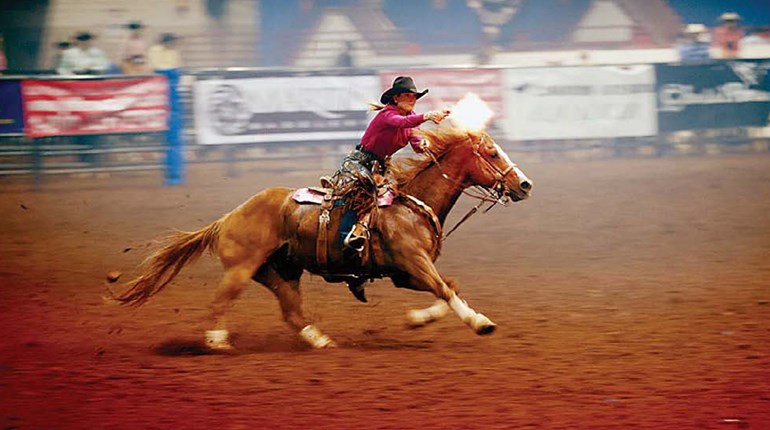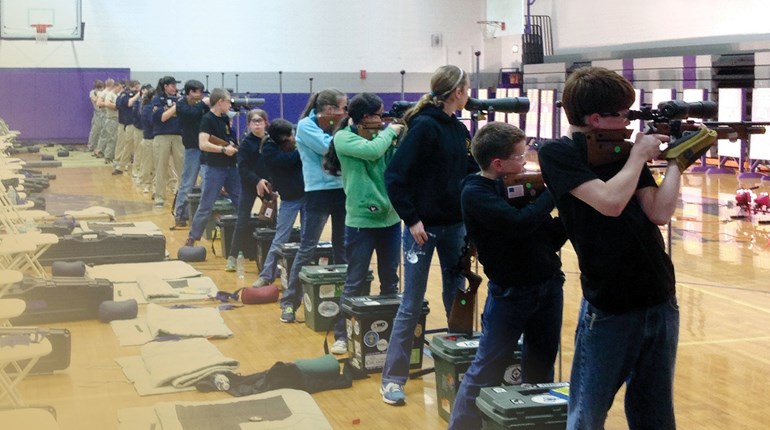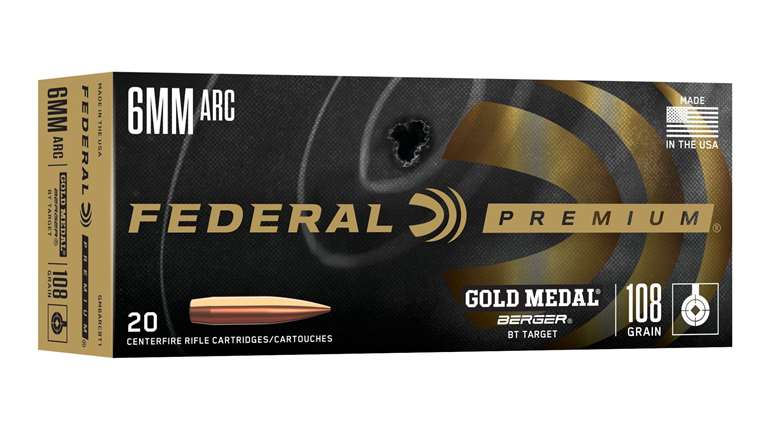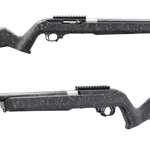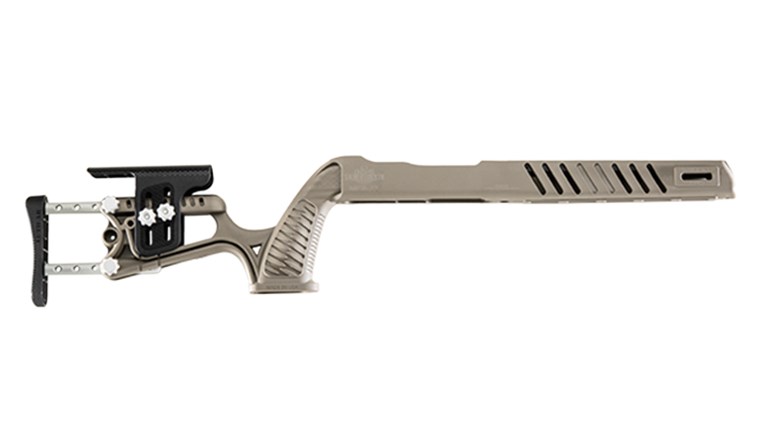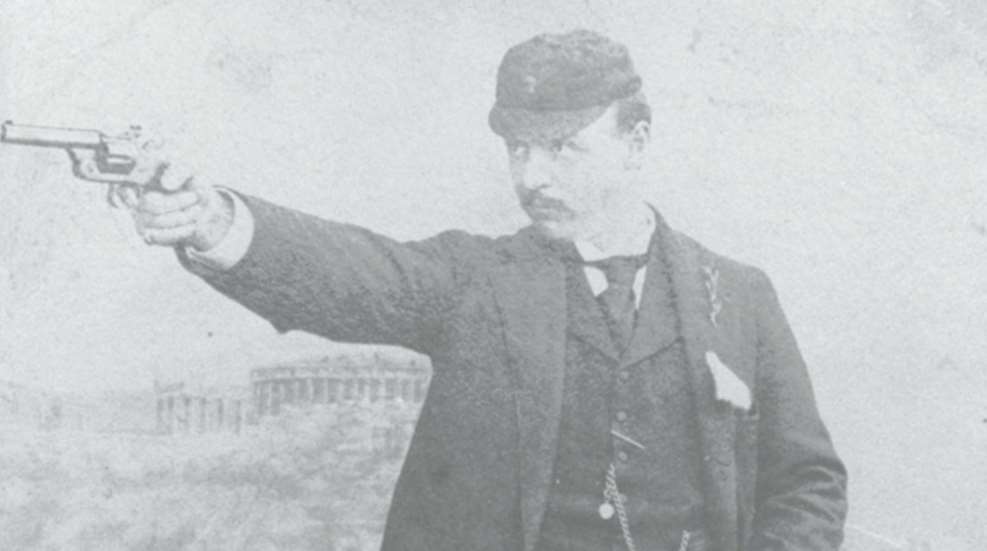
The below is an excerpt from the 1978 book, Olympic Shooting, written by Col. Jim Crossman and published by the NRA.
1896—Athens: The First Shots For Record
By Colonel Jim Crossman
When Her Royal Highness, the Queen of Greece, pulled the trigger on April 8, 1896, she fired the first shot for record in a new era—the shooting matches of the modern Olympic Games. Of the 21 scheduled games through 1976, three were cancelled because of war (1916, 1940 and 1944) and two, unfortunately, did not include shooting events (1904 and 1928). Editor's note: The 2020 coronavirus pandemic added 2020 to the list, although the Tokyo Games are currently slated to take place next summer. Shooting has been an important part of the other games, and the Americans have generally done well—starting as far back as the first games in 1896.
When the First International Olympic Games were assigned to Greece, all was joy and merriment among the Greeks until the realities of the problem filtered through. The problem was money, but Crown Prince Constantine took an active interest and made a worldwide appeal to Greeks, and the problem was eventually overcome. The shooters benefitted from the Greek enthusiasm by being privileged to use "the prettiest shooting house in the world," some 200 feet long and entirely of snow-white marble. Marble pillars separated the 30 firing points, and a series of baffles and embankments stopped any stray bullets, making this 300-meter (333 yards) safety range handsome and efficient.
Considering the times, the means of communications, and the fact that the modern Olympics were dreamed up and promoted by a small group of men, it is surprising how successful the first Games were. There were about 10 countries represented and something like 350 competitors. The U.S. squad included 14 people, four from Princeton and practically all the rest from the Boston Athletic Association.
John B. Paine, a member of the Boston Athletic Association, was selected to represent the club in shooting events in the Olympics. Both John B. and his brother Sumner were fine pistol shots. The publications of the day are full of fine groups and spectacular scores made by John and Sumner. (See Sumner in the photo at the top of this article—Ed.) Sumner Paine was working in Paris and shooting in the famous French Gastinne-Renette Galleries with considerable success, when John suddenly appeared on the doorstep and wanted Sumner to go along with him on the next train to Athens.
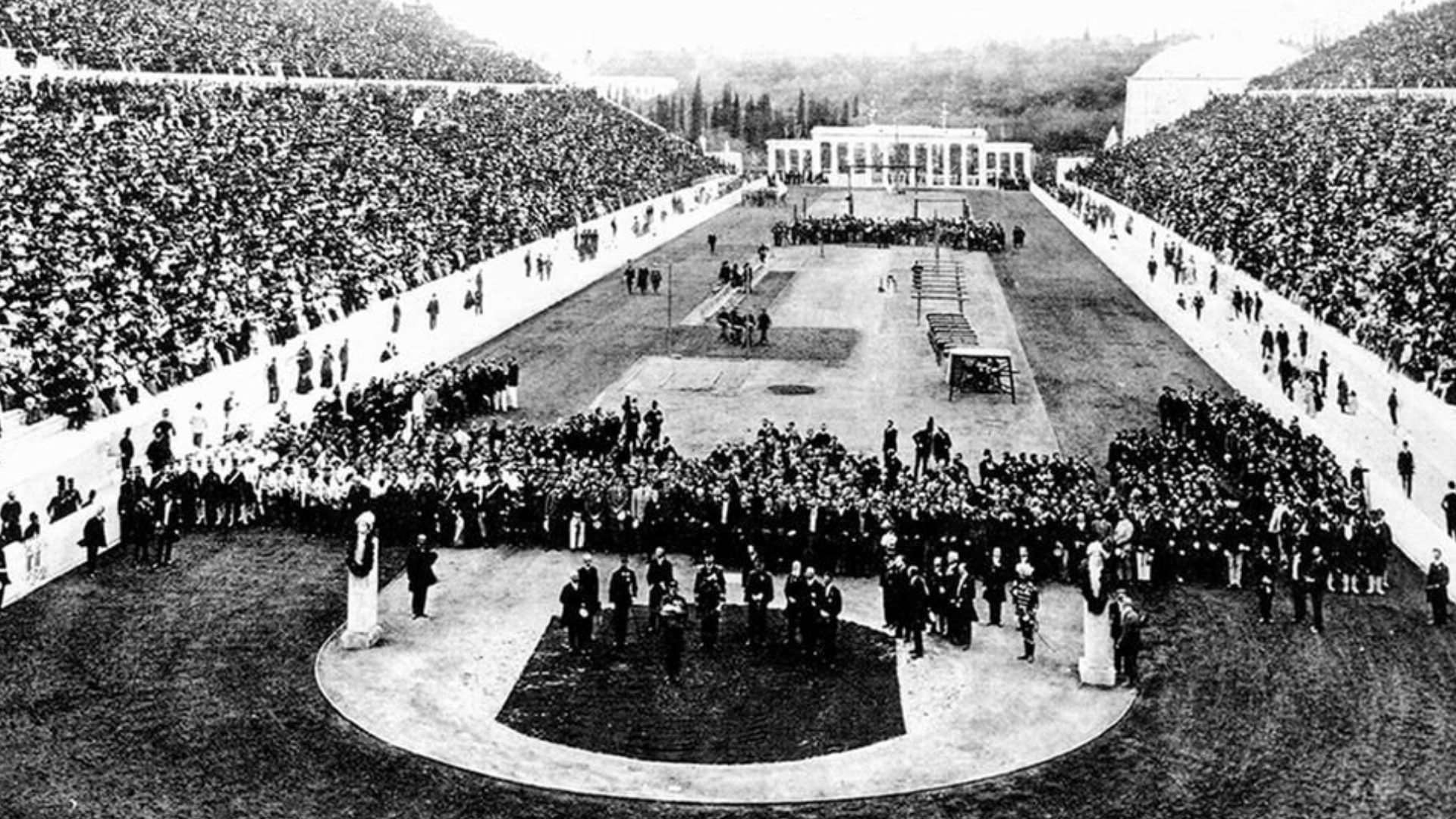
The only thing the brothers could find out about the proposed matches in Athens was that a target revolver match was to be fired at 30 meters (33 yards). Since his regular gallery load was too light for this distance, Sumner spent the afternoon working up a smokeless powder load that shot well at 30 meters. He finally settled on a load of about 4¼ grains of Nitro powder behind a round bullet cast by George R. Russell & Company of Boston.
Being uncertain about the events and the conditions, the Paine brothers took along everything they could think of, including a Colt Army revolver, a Smith & Wesson Russian revolver, and a pocket gun for each of them, plus John's .22-caliber Stevens pistol and Sumner's fine .22 Wurfflein single-shot. Not knowing the courses and thinking the matches might be the re-entry type, where they could enter and shoot as many times as they wished, they took along 3,500 rounds of ammunition. This turned out to be more than enough. They ended the matches with 3,404 rounds left—having fired just 96 rounds total.
The handguns carried by the Paine brothers were representative of the best target shooting guns of the time. The Colt Army revolver was the famous old single-action gun, made from about 1873 to the present time, although with some gaps in production. Also known as the Peacemaker and the Frontier Six-Shooter, this revolver had a solid frame and was chambered for many cartridges and made in a number of barrel lengths and other variations. Loading was done through a gate on the right side of the frame, filling one chamber at a time as the cylinder was rotated past the loading gate.
Although the Colt revolver was made in a target version known as the Bisley model, the Smith & Wesson No. 3 Single Action or Russian was usually the choice of the knowledgeable shooter. The Russian was made in large quantities. The Smith & Wesson folks got an order to make these guns for the Russian government, starting around 1870. Before they were through, S&W had made around a quarter-million for Russia and had devoted their entire factory production to them for five years. Meanwhile, Colt was busy during those five years making the Colt name a household word, especially in the West.
The commercial model of the Russian, the New Model introduced about 1878, was highly regarded as a target gun and was usually chambered for the .44 Russian cartridge. Like the Colt, this revolver was also a single-action, but unlike the Colt with its solid frame, this was the break-open type. The barrel and cylinder were hinged at the forward end of the frame. A latch on an extension of the barrel fitted behind protruding ears on the frame just ahead of the hammer. This lock held the gun closed during firing. By raising it, the gun could be broken open, pivoting on the hinge pin.
During these early days of handgun shooting, the revolver was not considered much of a gun, and Sumner Paine reported from Paris in 1896 that it was only in the past couple of years that the good French shooters had taken up the revolver.
Strangely enough, a Paine namesake but no relative, Ira Anson Paine, was one of the men responsible for giving the revolver a respectable name in competitive shooting. Ira Paine was a great competitor and made a name for himself as a trick shooter, as well as a professional shot. After much experimenting, he picked the .44 S&W Russian as his gun both for trick shooting and for competition. In the latter three years of his life he set many records, partly as a result of a running feud between Ira and two other professional shots, the Bennett brothers.
Ira Paine had worked with Gastinne-Renette in firing many thousands of shots from many different revolvers before deciding that the Russian was the gun to pick. Ira did such spectacular shooting in Europe, as well as in the United States, that he was knighted by the King of Portugal and was made a Chevalier of the Royal Order of Jesus Christ. Thereafter, he was commonly known as Chevalier Paine.
The .22 long rifle rimfire cartridge had been in commercial production about 10 years by the time John and Sumner Paine went to Athens. It rapidly won a place in target shooting because of its low cost, its light recoil and noise, and its fine accuracy. The pistol in this caliber that John took with him was the tip-up action Stevens single-shot, a most popular pistol of the time. Like the S&W Russian, it was hinged at the front of the frame, and the barrel tipped on that hinge to expose the chamber for loading. The gun had an external hammer and it was locked closed by a lateral pin. Pressing on the protruding left end of the pin released the barrel. This basic pistol was made for many years and in many models, including the Gould, Conlin, Lord, Offhand and Diamond. Most of the models were discontinued after World War I, except the Offhand. Many shooters grew up clutching an Offhand in their young hands.
Sumner Paine's .22 pistol was made by William Wurfflein of Philadelphia. It, too, was a single-shot pistol with a tip-up barrel, hinged at the front end of the frame. The release for the barrel was a thumb-lever on top of the grip behind the hammer. Wurfflein pistols are not well known today because there were not many produced, most being made on special order for individuals. The guns were popular match pistols in their day, very well made and quite accurate, winning many matches and setting many records. Sumner Paine knew much about the shooting equipment popular in Europe and the United States through his extensive experience at Gastinne-Renette's, and at other matches.
He knew that John and he were taking with them the best available equipment when they departed for Athens. The only concern of the brothers was that they did not know the match conditions, and this would have to wait until they got to Athens.
Having arrived in Athens, the Paines looked up at the rest of the American contingent and immediately ran into something shooters have been contending with since—the amateur rule. The brothers were required to produce a certificate that they both were bona fide amateurs. The vice-consul provided them with a certificate which seemed to satisfy the officials.
Still not knowing the program, the Paines went to the range the next morning, with all their guns and ammunition, to discover that there was only one match scheduled for the day—30 shots with the military revolver at 25 meters (28 yards). The brothers were somewhat distressed at the target and the scoring system being used by the Greeks. The whole target was a "small fraction of an inch smaller than the 7-ring of the standard American target, reduced for the distance." The 7-ring is 11 inches in diameter, and if this is reduced from 50 yards to 30 meters, the diameter would be about 7¼ inches. Within this, the Greek target included scoring rings from 1 to 6 and a black bullseye about 5½ inches in diameter, within which was a white center about 2½ inches across that made sighting difficult.
The thing the Paine brothers liked even less was the scoring system in which the numerical score made was multiplied by the number of hits on the target. Thus, 6 shots on the target all in the 1-ring gave a value of 6, which multiplied by the total hits gave a score of 36. Three hits on the target, all in the 4-ring, gave a value of 12, which multiplied by the three hits also gave 36. It can be seen that there were many combinations of hit and value, but it was obvious that a miss was penalized heavily, first in not adding anything to the value and second in the multiplication. The same scoring system and the same target, incidentally, were used for both the military revolver and the target revolver, the only difference being that the target was set at 25 meters for the military gun and 30 meters for the target revolver.
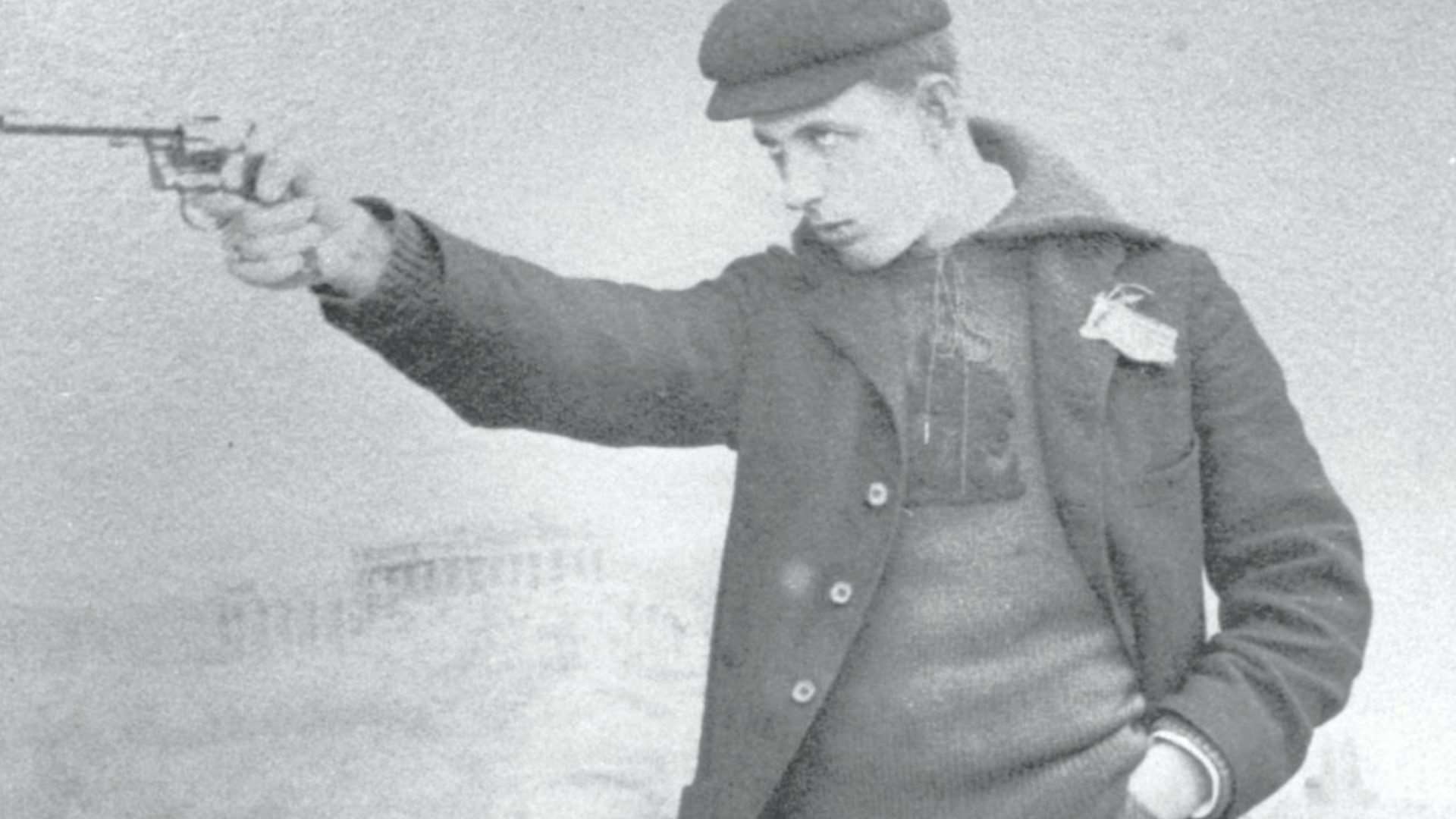
However, by the end of the first string it was clear the Paines far outclassed the other shooters. When the last shot had been fired, John had a grand total of 442, with actual count of 85 and 5 misses. Sumner had second place with 380, composed of 79 with 7 misses. A Dane took third, with less than 200 points. The Paines undoubtedly would have shot better if they had rested, had gotten used to the strange target and had sighted in their guns.
But it was different on the second day of the match—the day of the target revolver shooting. The other competitors had watched the Paines carefully and taken note of all their practices. Take blacking the sights, for example. The Paines used a small smudge to black the front and rear sights, so there would be no glare from them.
The Greeks thought this was a pretty good idea, and the next morning clouds of smoke poured from the range as each shooter built his little smudge. But somewhere along the line, the point was missed and the shooters were blacking the barrel, the trigger, the cylinder, the grips—and if any got on the sights it was by accident. But at least it was recognized that the Americans had something in the way of technique and guns, as the final report says: "They had brought with them their own arms revolvers, fabricated on a most superior system and endowed with remarkably correct aiming power."
After looking the situation over, the Paine brothers decided there was no use adding insult to injury, since they so far outclassed the other shooters, and whoever won the first day's match would not shoot on the second. Sumner Paine, shooting his S&W revolver, thus had the show pretty much to himself, and with his 24 hits he made the identical score as his brother on the day before—442. M. Jensen, from Denmark, took the second prize.
The third match was for "pistols of usual caliber" at 25 meters. The Paines intended to shoot their .22 handguns here, but the guns were promptly ruled out as not being of usual caliber. All the other contestants in the match used muzzleloading pistols of about .45 caliber. Although the Greeks offered to lend them pistols of usual caliber for use in the event, the Paines stayed out, each having already won a match. Capt. I Phrangoudhis and G. Orphanidhis, both from Greece, took the awards.
In the 300-meter rifle match, things were reversed, with Orphanidhis shooting 1583 points with 37 shots for first, and Capt. Phrangoudhis in second place. The 200-meter match (222 yards) saw law student P. Karassevdas having 40 good shots for a total of 2320, and Pavlidhis second with 1978 points.
The closing ceremony was as impressive as the opening ceremony had been. The King gave the awards, consisting of a special silver medal, a diploma, and an olive branch for first place, along with a number of special awards. The second-place winners received a special bronze medal and a laurel branch. After the winners had marched around the stadium, packed with more than 70,000 spectators, they halted in front of the royal box. When the King said, "I announce hereby the closing of the First Olympiad," everyone agreed it had been a surprisingly splendid and well-organized affair.
See more: NRA World Shooting Championship: Musings From The Crowd













